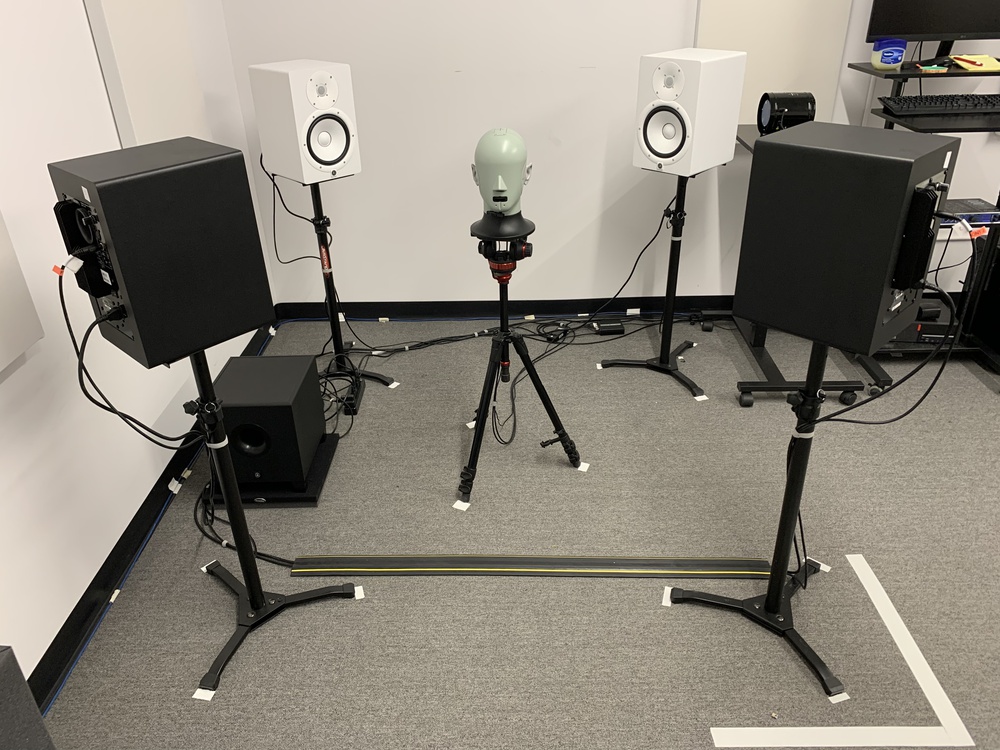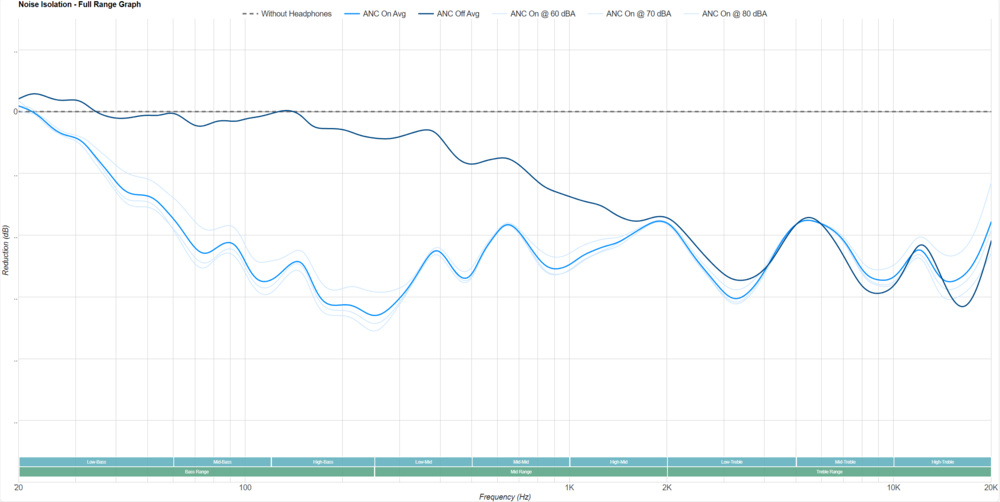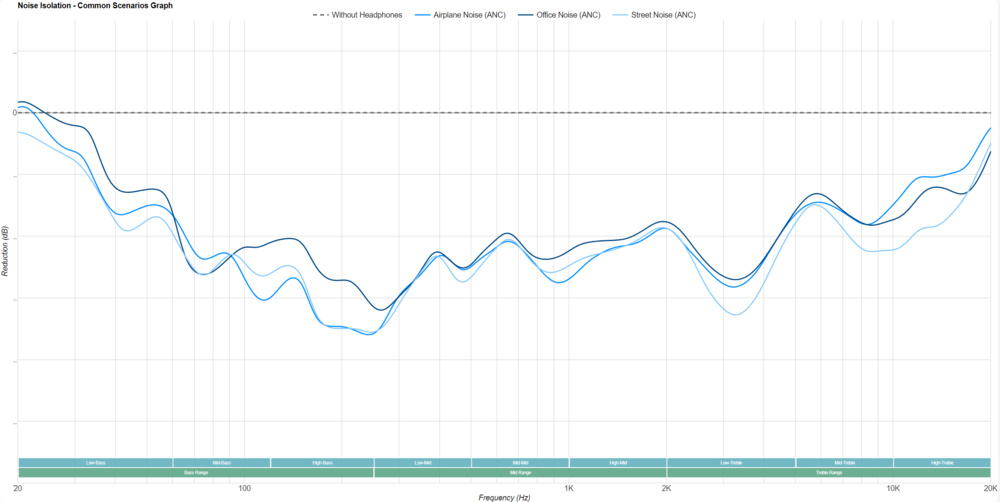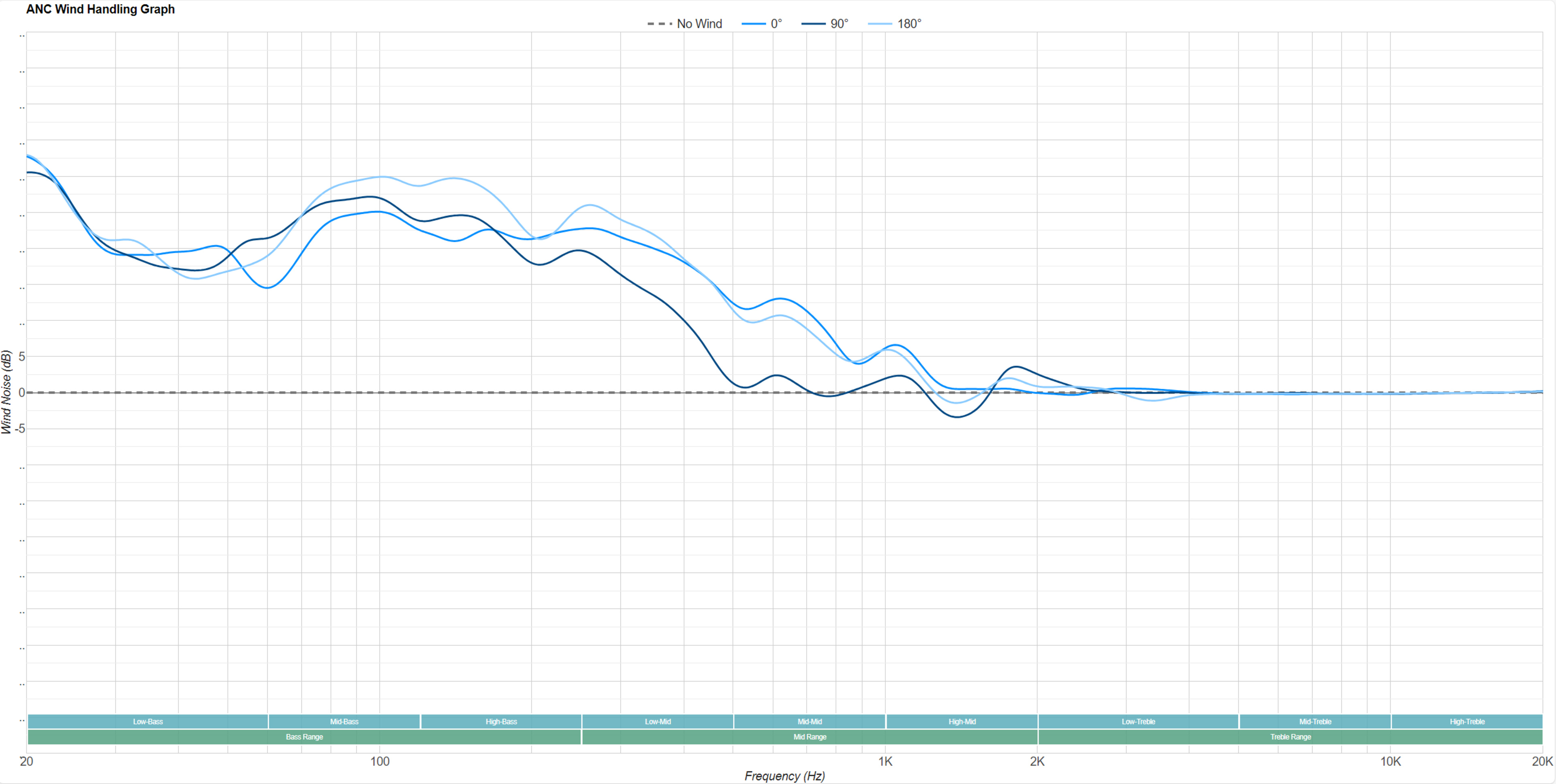- Table of Contents
- Intro
- When It Matters
- ANC: How Does It Work?
- Noise And Noise Isolation
- Our Tests
- Feedback
- Comments
Our Headphone Tests
Noise Isolation
- 100.0% Overall Attenuation
Sometimes, the outside world can be too much to hear. Sounds like traffic outside your window, coworkers talking, and airplane engines make it challenging to focus on your audio and create a distracting, ever-present soundscape that music alone can't hide. If you want to lessen these annoying sounds, you'll want to consider a model's noise isolation performance, representing their ability to block ambient noise passively and actively.
Not all headphones are created equal in this regard, though. While most headphones provide some level of passive isolation through physical design choices such as dense ear cup padding or memory foam ear tips, this may not be enough for true peace and quiet. More and more headphones are using active noise cancelling (ANC) systems, which enhance isolation by nullifying sounds that seep into the headphones. Not all noise is created equal, either. Our noise isolation tests cover a range of sounds, from pink noise to give you a better picture of overall performance to more dynamic real-life scenarios. We also test wind noise and voice handling.
If you're shopping around for headphones with noise isolation in mind, you'll want to check out our recommendations for the best noise cancelling headphones and best noise cancelling earbuds.
Test results
When It Matters
If you like to hang about in noisy environments like early morning commutes by train or busy offices, a good, isolating pair of headphones will keep distracting ambient noise from interrupting your listening experience. Poor noise isolation can also be a significant issue, depending on the loudness of your environment. Although listening at high volumes naturally overpowers ambient noise of lesser amplitudes, this isn't great for your overall ear health. As a result, more active and passive isolation is required at higher ambient volumes.
Some headphones aren't designed for noise isolation, and depending on your needs, you may even prefer less isolation. Open-back audiophile headphones like the Sennheiser HD 800 S purposefully allow exterior noise to enter the ear cup to create a more natural soundstage. Sports headphones like the Shokz OpenRun Bone Conduction completely bypass your ear when it comes to sound delivery, so you can stay aware of your surroundings when exercising outdoors.
ANC: How Does It Work?
In short, noise cancelling technology utilizes microphones placed somewhere on the headphones to pick up ambient sound waves. Then, a soundcard receives that signal and processes it by inverting it. The sound produced is called 'anti-noise,' which is then played via the headphones' speakers, cancelling out that noise through destructive interference.
However, in reality, not all ANC systems have the same design, and their capacities are dependent on their hardware and mic placement. There are a few ANC systems out there:
- Feedforward: This setup uses ANC microphones placed outside the ear cups (for over-ears and on-ears) or ear canal (for in-ears and earbuds). These microphones can quickly capture and react to noise. It's the most common kind of ANC system.
- Feedback: In this setup, ANC microphones are placed inside the headphones, whether within the ear cup or ear tip. This means that the microphones pick up sound in a way that's similar to how you hear it.
- Hybrid: Usually found in higher-end headphones, hybrid ANC is a combination of feedback and feedforward, giving you the best of both worlds. Mics are placed inside and outside the headphones, allowing this system to cancel more of the frequency spectrum.
Noise And Noise Isolation
Not all sounds have the same frequencies. It's unlikely that you'll only encounter sounds in isolation—unless your life is otherwise silent. In everyday life, you'll likely hear a wide array of noise from many different, and near simultaneous, frequency bands and at different volumes. However, knowing where on the spectrum they reproduce can help you understand what's at stake in each range.
Bass Range Noise
The bass range is where you'll find rumbly bus and plane engines, traffic, and construction. However, these low sounds are some of the hardest to block out passively. Longer waves can pass through material more easily than shorter waves and are harder to absorb. As a result, it's very hard for most headphones to passively isolate this range. However, this is where ANC systems tend to shine. Some of the best noise cancelling headphones can block out over 15 dB of sound in this range.
Mid Range Noise
When it comes to mid-range sounds like ambient speech, some headphones can provide adequate passive isolation in this range alone. However, ANC can still offer a worthwhile gain here. Noise cancelling can continue its full-force tackling of sounds in the low-mid, but you may not notice quite as much of a difference between ANC on and off the further you get toward the treble range.
Treble Range Noise
Whiny computer fans, dishes clinking together, and even some AC units are examples of treble range noise. Most headphones with a closed-back design can block out a significant amount of these sounds passively. Earbuds especially perform well in this range, too. However, most ANC systems don't offer improved isolation here, so the differences between ANC on and off can be quite slim.
Our Tests
Testing Procedure
We start in a room with a low noise floor. We also use noise reflection materials to mitigate unwanted sound. Our setup utilizes a B&K 5128 head and torso simulator (HATS) test rig centered between four speakers and one subwoofer. The height of these speakers are level to the rig's ears. For Full Range, Common Scenarios, and Voice Handling tests, we play audio from all speakers simultaneously.
This is the basic setup of most of our noise isolation tests. As you'll see below, each test has some small deviations, including swapping the noise measured.
Noise Isolation - Full Range
- 100.0% Overall Attenuation
This test uses pink noise as our test signal. We used a sine sweep in the past, but it didn't always give us true-to-life results. This was especially an issue for ANC systems that take time to adapt to noise, which are now more common. These kinds of ANC headphones attenuate less noise in the first few seconds of encountering background sound but improve their performance once they have time to respond and adapt. Using pink noise allows us to account for this response time and more effectively measure their performance.
We record with the following setup: no headphones, headphones on but ANC off, and with ANC enabled (if available). If there's ANC, we also run this test at three different volumes (60 dB, 70 dB, and 80 dB). It's also worth mentioning that we reseat the headphones between each sample we take.
This test is useful if you want to see the difference in isolation between each range. That said, if you want to see how the headphones we've tested on this test bench perform, you'll want to look at this table, which lists all products currently available in order of their noise attenuation.
Noise Isolation - Common Scenarios
- 10.0% Airplane Noise Attenuation
- 10.0% Office Noise Attenuation
- 10.0% Street Noise Attenuation
You'll unlikely encounter pink noise or sounds isolated to a small frequency band in the real world. If you want to know what to expect in everyday scenarios, this is the test for you. It complements our Full Range results by presenting three dynamic scenarios you'll likely want to block out: Airplane Noise, Office Noise, and Street Noise.
We use three sample recordings for this test; they're sourced from the European Telecommunications Standards Institute (ESTI), which you can find within their background noise database. You may need to raise your device's volume for the most accurate playback since the recordings aren't very loud.
Since this test is scored, you can use our table tool to search for headphones that perform the best in a particular scenario. We've already done the heavy lifting, so you can check the tables for airplane noise, office noise, and street noise, with the products sorted by noise attenuation.
Noise Isolation - Voice Handling
If you work at a busy office or like to wear headphones when you're out and about at a cafe or supermarket, you'll hear voices all around you. This test puts together four different voice recordings (two male and two female) from Peter Kabal's Telecommunications & Signal Processing Laboratory Speech Database at McGill University. You can hear the difference in noise isolation for yourself. Keep in mind that although the bulk of speech falls within the mid range, deeper voices tend to produce some bass, while higher-pitched voices tend to produce some treble.
You can hear the audio samples used below. You may need to raise your device's volume for the most accurate playback.
Unlike the previous tests, this test isn't scored. It acts as a reference point; you can compare recordings to better understand what suits your needs.
ANC Wind Handling
If you've ever been outside, you know that wind noise can be annoying. Unlike other sounds that come from an external source, like voices or engine rumbles, wind noise physically hits the ANC's microphones. As it comes into contact with the microphone, there's a change in the wind's velocity, creating a change in pressure. This change in pressure is interpreted by the microphones as noise, even though the sound would have never reached your ear otherwise. The ANC system then plays anti-noise to cancel it out, resulting in a louder noise than if the ANC was simply turned off.
This test is only performed if the headphones have an ANC system. If the headphones also have a wind reduction feature, we'll use it.
Unlike the other tests, which use a reference file, we use an electrical fan placed 30 cm away from the HATS ears. We also take three passes at different angles (0°, 90°, and 180°). Wind noise typically has a flat response below 300 Hz (low-mid range) and tapers off around the same frequency band.
This test isn't scored either. If reducing wind noise is your top priority, you'll definitely want headphones that have a wind reduction feature. If you're interested in learning more about this, our R&D article on noise isolation is right up your alley!
If you're looking to isolate yourself from as much sound as possible, noise cancelling headphones are some of the best choices on the market. You may pay top dollar for a high-quality ANC system, but it can be worth it for some peace and quiet.
Feedback
We love hearing from you! Do you have any questions or suggestions concerning our methodology? Are you interested in knowing specific details about our setup, process, or the philosophy behind our tests? We'd love to hear from you in the forums. You can also send us an email at feedback@rtings.com.
LOOKING FOR MORE?
Test Bench 1.7 represents the newest changes to our noise isolation test. If you crave a more in-depth explanation of how we test, our methodology, and more, you'll want to check out our R&D article.




